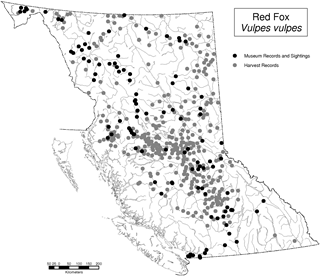The Red Fox is familiar to most of us, with its distinctive often red fur, long legs, black stockings, sometimes black muzzle, pointed black-tipped ears and large white-tipped bushy tail. Coat colour may vary from the well-known red colour form (pale golden to coppery coloured, to a dark cherry red) to grey or brownish, to silver (black with light-tipped guard hairs).
Biology:
Red Foxes are often seen during the day. They are opportunistic feeders, feeding on a variety of plants and animals (Hatler et al. 2008). Rodents are an important part of their diet (e.g. voles pocket. mice, shrews and chipmunks), but they will also eat Snowshoe Hares, cottontails, marmots and ground squirrels, birds and birds eggs, as well as invertebrates (insects, molluscs,earthworrms etc.) (Hatler et al. 2008, Wikipedia 2012). Plant material they will consume includes berries and corn (Hatler et al. 2008). Population in BC may fluctuate with the numbers of Snowshoe Hares (Hatler et al. 2008).
Red Foxes breed from February to March in BC (Hatler et al. 2008) and 4-6 kits are born in the spring.
Habitat:
The Red Fox is found in a variety of habitats throughout its range, from prairies and scrubland to forest settings. It shows preference for open habitats with a patches of trees and shrubs, and is found in "natural meadows and grasslands in BC, in large expanses of alpine tundra and subalpine parkland in the north, and...in a variety of agricultural and urban areas" (Hatler et al. 2008).
Global Range:
The Red Fox has a large global range and is found in North America and Eurasia, southern Australia, and with several populations in North Africa (Wikipedia 2011). It is introduced in Australia. In North America, the Red Fox is native in boreal regions, but was introduced in temperate regions (Hatler et al. 2008, Wikipedia 2011). "In temperate North America, Red Foxes are derived from European Red Foxes, which were introduced into the Southeastern United States around 1650-1750 for fox hunting, and from there to California for the fur trade. The first introduction is attributed to Robert Brooke, Sr., who is said to have imported twenty-four Red Foxes from England. The introduced European Red Fox may have interbred with the scarce indigenous population to produce a hybrid population" (Wikipedia 2011).
BC Range:
In British Columbia, the Red Fox is found throughout the mainland, exclusive of coastal areas, but is not found in the Queen Charlotte Islands, or on Vancouver Island or the Gulf Islands (Hatler et al. 2008).
Taxonomy:
According to Hatler et al. (2008), ten subspecies of Red Fox are recognized in North America and, although there has been no genetic research to support the subspecies, two are currently recognized in BC:
1) Vulpes vulpes abietorum (Central BC)
2) Vulpes vulpes cascadensis (southern BC).
However, introductions and escapes from fur farms complicate the taxonomy.
